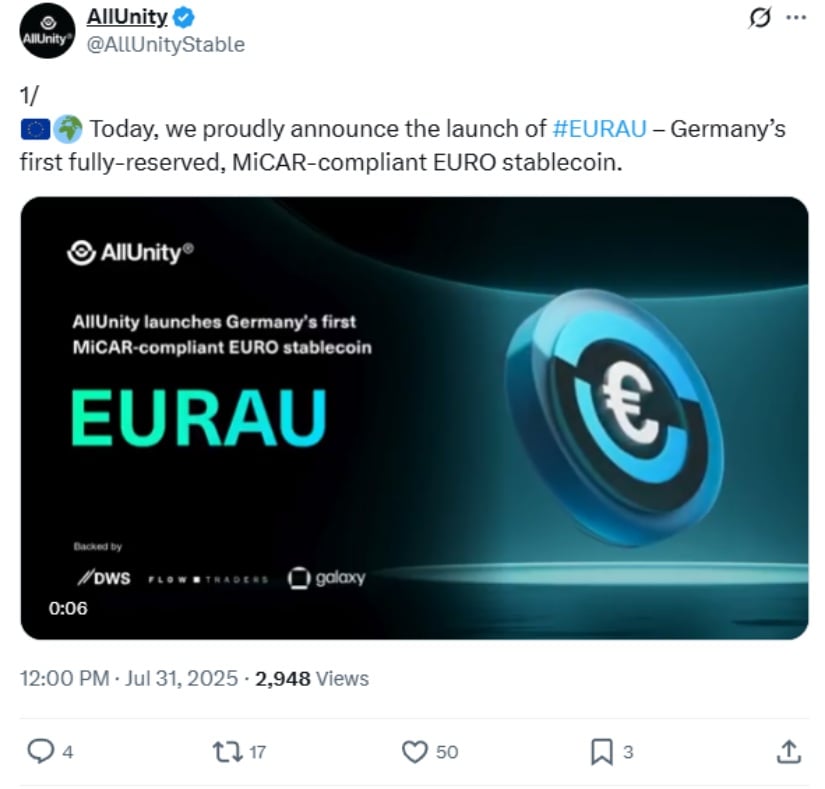Deutsche Bank Shatters Barriers: EURAU Stablecoin Goes Live as Germany’s First Fully-Regulated Digital Euro
Traditional finance meets blockchain as Germany's banking giant plants its flag in crypto territory.
The EURAU launch marks a watershed moment—regulators finally playing ball while banks scramble to stay relevant.
How it works: Every token backed 1:1 with cold, hard euros. Because apparently 'trustless' systems still need old-school guarantees.
Why it matters: When institutional heavyweights enter the arena, the game changes. Whether that's good news for decentralization purists? Debatable.
The bottom line: Another brick in the wall of crypto legitimacy—just don't ask who owns the construction company.

Germany made financial history on July 31, 2025, with the launch of EURAU, the country’s first fully regulated euro-backed stablecoin.
EURAU comes from AllUnity, a joint venture between Deutsche Bank’s DWS Group, crypto investment firm Galaxy Digital, and Dutch market maker Flow Traders. After 18 months of development, the company received approval from Germany’s financial watchdog BaFin to issue the first MiCA-compliant euro stablecoin under strict European Union regulations.
The launch puts Germany at the front of Europe’s digital money race. Unlike many crypto projects that operate in gray areas, EURAU follows every rule in the EU’s Markets in Crypto-Assets (MiCA) framework, which took effect in 2024 to clean up the wild west of digital currencies.
Why This Launch Matters
Stablecoins are digital currencies designed to maintain steady value by backing each token with real money or assets. Most stablecoins today use US dollars, giving America huge influence over digital payments worldwide. EURAU breaks this pattern by using euros instead.
The timing is perfect. Euro-backed stablecoins grew 44% in the first half of 2025, jumping from $310 million to $480 million in total value. But this still represents less than 1% compared to dollar-based stablecoins, showing massive room for growth.
“The license marks an inflection point for the European financial industry as it enables the issuance of the first fully regulated EUR stablecoin out of Germany,” said Stefan Hoops, CEO of DWS, in a press release.
Alexander Höptner, AllUnity’s CEO and former head of crypto exchange BitMEX, called the launch a step toward building “a truly secure, transparent and compliant digital cross-border payment ecosystem for Europe and global markets.”

Source: AllUnityStable
How EURAU Works
EURAU operates like a digital version of euros stored in a bank account. Each EURAU token is backed 1:1 with actual euro reserves held in European banks. The company cannot lend or invest these reserves, keeping them SAFE and available for users who want to cash out.
The stablecoin launched on the ethereum blockchain and began trading immediately on Bullish Europe, a BaFin-regulated exchange. Initial trading pairs include BTC/EURAU and USDC/EURAU, with Flow Traders providing market-making services to ensure smooth trading.
Unlike many crypto projects, EURAU targets businesses rather than individual traders. The stablecoin is designed for financial institutions, fintech companies, and corporate treasuries that need reliable digital euros for cross-border payments and 24/7 settlements.
The project brings together three different types of expertise. DWS provides traditional banking knowledge and regulatory experience. Galaxy Digital contributes crypto technology and blockchain expertise. FLOW Traders adds market-making skills to keep trading smooth and prices stable.
Regulatory Breakthrough
EURAU’s success stems from its regulatory-first approach. The project began in December 2023 when the three partners announced plans to create a joint venture. They spent months working with German regulators to meet every requirement.
BaFin granted AllUnity an Electronic Money Institution license on July 1, 2025, after thorough review. This license requires monthly audits, transparent reporting, and strict consumer protections. If AllUnity ever goes bankrupt, EURAU holders get their money back first, ahead of other creditors.
The MiCA regulation has already shaken up Europe’s stablecoin market. Major exchanges like Binance and Coinbase delisted non-compliant stablecoins for European users, including Tether’s USDT, the world’s largest stablecoin. This created demand for regulated alternatives like EURAU.
Industry experts see growing institutional interest in compliant stablecoins. According to research firm analysis, institutional adoption of stablecoins in Europe could grow 40% in 2025 thanks to regulatory clarity provided by MiCA.
Market Impact and Competition
EURAU enters a small but growing market. Circle’s EURC currently leads euro-backed stablecoins with about €178 million in circulation, while Société Générale’s EURCV has €41 million. These amounts pale compared to dollar stablecoins, where Tether’s USDT alone exceeds $158 billion.
The disconnect is striking. About 40% of traditional foreign exchange trading involves non-dollar currencies, but less than 1% of crypto transactions use non-dollar stablecoins. This gap represents a huge opportunity for projects like EURAU.
Over 80% of the world doesn’t use the US dollar as their primary currency, yet most digital payments still require converting to dollars first. Euro-backed stablecoins could eliminate this extra step for European businesses.
Deutsche Bank’s involvement gives EURAU advantages over competitors. The bank’s reputation and existing relationships with European institutions could drive faster adoption. The project also benefits from Höptner’s extensive network in European financial markets from his previous roles.
Broader Implications
The EURAU launch reflects Deutsche Bank’s broader push into digital assets. In June 2025, the bank announced plans to explore both stablecoins and tokenized deposits. By July, Deutsche Bank revealed plans for a cryptocurrency custody service launching in 2026.
This represents a major shift for Europe’s largest lender, which previously avoided crypto ventures. The MOVE signals growing institutional acceptance of digital assets as legitimate financial tools rather than speculative investments.
Other major banks are watching closely. Similar projects could emerge across Europe as institutions recognize the benefits of regulated digital currencies for cross-border payments and treasury operations.

